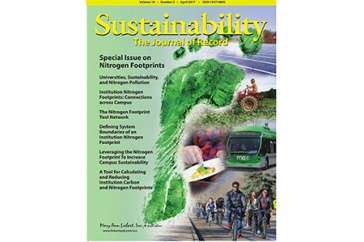UNH helps lead the way for campuses to measure their nitrogen footprints

Sustainability leadership efforts at the University of New Hampshire have contributed to a groundbreaking initiative to measure and reduce the nitrogen footprint left behind by campus activities like food waste and energy consumption. The new research is highlighted in the April 2017 special issue of Sustainability: The Journal of Record. The publication outlines research being done at UNH, and seven other institutions, to reduce emissions of reactive nitrogen (all forms of nitrogen except unreactive N2 gas) and prevent negative impacts on such things as water quality, air pollution, and climate change.
"Our goal is to make the nitrogen footprint a sustainability metric that all institutions across the world can track and manage," said Allison Leach, a doctoral candidate in natural resources and Earth systems science at UNH, a research associate at UNH's Sustainability Institute, and lead author of one of the featured studies in the journal. "A nitrogen footprint connects our everyday choices, such as food, utilities, and transit, to nitrogen pollution in the environment. Reducing our nitrogen footprint is vital because it can negatively impact not only the environment but also human health, from effects like smog and acid rain to global climate change."
Leach, who is also a guest editor on the special issue, worked with Jennifer Andrews, a project director at UNH's Sustainability Institute, to integrate the Nitrogen Footprint Tool into the next generation Campus Carbon Calculator, originally developed at UNH in cooperation with Clean Air-Cool Planet. A paper in the journal's current publication focuses on that work and outlines a newly developed tool that will measure both campus carbon and nitrogen footprints. The online tool will be launched in Fall 2017 and will give accessibility to hundreds of campuses to record and keep track of their own nitrogen and carbon footprints.
"We have found that initiatives to reduce a campus's carbon footprint can also reduce its nitrogen footprint," said Leach. "For example, at UNH, using a tool like this to reduce our nitrogen footprint could create local environmental benefits like improving the water quality of the Great Bay."
The journal's special issue features the first completed university-wide nitrogen footprint results. It brings together authors from eight institutions, including UNH, that make up the Nitrogen Footprint Tool (NFT) Network. The NFT helps estimate emissions of reactive nitrogen resulting from every day institutional activities like campus food service, energy use, transportation, fertilizer on grounds, and research activities. The publication features research, case studies and commentaries that call attention to the nitrogen footprint's impact and ways individuals and administrators can reduce it with strategies like simple food choices (vegetable protein rather than meat protein) and switching to renewable energy.
Research by John Aber, professor of natural resources and the environment, and Andrews is also included in the issue.
More information: An Integrated Tool for Calculating and Reducing Institution Carbon and Nitrogen Footprints, online.liebertpub.com/doi/pdfp … 9/sus.2017.29092.aml
Journal information: Sustainability: The Journal of Record
Provided by University of New Hampshire





















